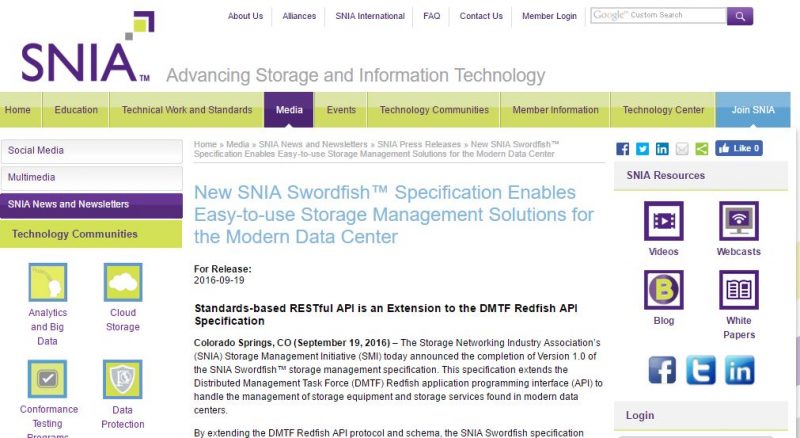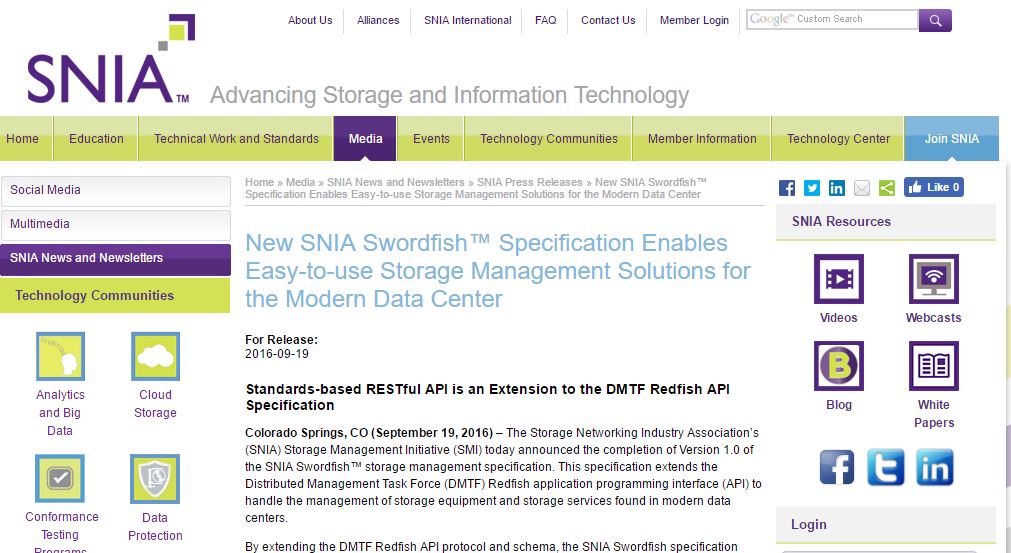Redfish is the next-generation of server management schemes that will eventually replace IPMI as the primary method of server management. We have already seen implementations in the STH lab from major server vendors such as Dell and Supermicro. Redfish is also a major component of Intel’s Rack Scale Design initiative where the members are the who’s who of server vendors. The Storage Networking Industry Association (SNIA) launched their RESTful API called SNIA Swordfish which is an extension of Redfish specifically catered to managing storage systems.
Speaking with vendors about Redfish, there is still much work to be done and additional scope to cover. At the end of the day, this is where the server vendors are investing their development dollars to support Redfish as the next-generation server management protocol. With the storage industry’s non-profit association adopting and extending Redfish, we are seeing some of the forward thinking work take place. The end-state will be tools to manage servers and storage from multiple vendors all with a common set of APIs. This will in turn lead to a new generation of server and storage management platforms that do not rely upon IPMI.

Here is an excerpt from the SNIA press release:
The Storage Networking Industry Association’s (SNIA) Storage Management Initiative (SMI) today announced the completion of Version 1.0 of the SNIA Swordfish™ storage management specification. This specification extends the Distributed Management Task Force (DMTF) Redfish application programming interface (API) to handle the management of storage equipment and storage services found in modern data centers.
By extending the DMTF Redfish API protocol and schema, the SNIA Swordfish specification helps to provide a unified approach for the management of storage and servers in hyperscale and cloud infrastructure environments, making it easier for IT administrators to integrate scalable solutions into their data centers. The same easy-to-use RESTful interface is used, along with JavaScript Object Notation (JSON) and Open Data Protocol (OData), to seamlessly manage storage equipment and storage services in addition to servers.
“SNIA Swordfish is designed to integrate with the technologies used in cloud data center environments and can be used to accomplish a broad range of storage management tasks from the simple to the advanced,” said Don Deel, chair of SNIA’s Storage Management Initiative. “SNIA Swordfish is easier to understand and implement than legacy standards, which will accelerate its adoption and use by storage equipment vendors and management application vendors.”
SNIA Swordfish has been designed around management use cases that focus on what IT administrators need to do with storage equipment and storage services in a data center. As a result, the API provides functionality that simplifies the way storage can be allocated, monitored, and managed. For example, the API is able to associate different classes of service with storage systems having different levels of performance in a data center. Once this has been done, an IT administrator can allocate storage to servers or virtual machines by specifying the storage class of service needed, without worrying about many of the details associated with finding or configuring a particular storage system with the desired performance characteristics. The API defined by the specification also supports having value-add, vendor-specific functionality alongside standardized functionality, to accommodate future storage-related capabilities.
Defined by the SNIA Scalable Storage Management Technical Work Group, the SNIA Swordfish specification is the result of a broad industry collaboration involving the leading companies in the storage industry.
Jeffrey Snover, technical fellow, Microsoft commented, “Microsoft is an active participant in the SNIA Technical Work Group developing SNIA Swordfish to make sure the most important scenarios for this specification will work well with our products. Because SNIA Swordfish is an extension of Redfish that will be widely adopted in virtualized environments, vendors will no longer need to produce versions for any one particular operating system.”
Jeff Hilland, president, DMTF added, “By extending DMTF’s groundbreaking Redfish standard, SNIA Swordfish brings the ability to manage storage and storage services in a way that is consistent with how servers and fabrics are managed. This is the type of approach needed for the management of today’s hyperscale and cloud infrastructures.”





psst.. Typos in the title and first paragraph SINA => SNIA.